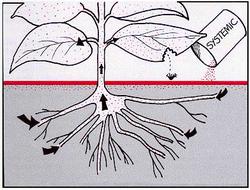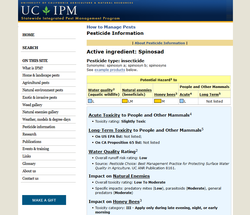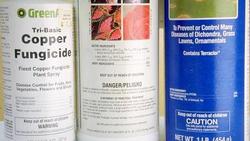What are Pesticides?
What's in Them, How They Work

> How they work
> Where pesticides come from
> What's in them
> Toxicity levels
> Types of pesticide formulations
What's a pesticide?
Many people associate pesticides only with synthetic chemicals, but a pesticide is any material used to control, prevent, kill, suppress, or repel pests. There are many different types of pesticides, each focused on the group of pests they are designed to control. Some of the most common include:
Fungicide
Kills fungi that may infect and cause diseases in plants, animals, and people
Herbicide
Kills weeds and other plants that grow where they are not wanted
Insect Growth Regulator
Disrupts the growth and reproduction of insects
Insecticide
Kills insects
Miticide
Also called acaricides, kills mites that feed on plants and animals
Molluscicide
Kills snails and slugs
Repellent
Repels unwanted pests, often by taste or smell
How they work
Here are some terms that are important to understand when selecting a pesticide, especially the way the pesticide works on the targeted pest:
Narrow spectrum / selective
Kills only a few closely related organisms
Broad spectrum / non-selective
Kills a range of pests and non-target organisms
Contact
Kills when it touches the external surface of the target organism

Absorbed and circulates throughout the target organism after entering through an initial uptake site (e.g., the mouth in animals or the roots or leaves in plants)
Fumigant
Forms gases that are toxic to plants, animals, and microorganisms
Pre-Emergent herbicide
Inhibits weed seeds from sprouting or emerging from the soil
Post-Emergent herbicide
Used after weeds have emerged from the soil
Residual
Remains toxic to pests long after application.
Where they come from
The origin of a pesticide may be natural or man-made, and produced from organic (carbon containing) materials or inorganic (not containing carbon). Natural and organic do not automatically mean that the material is safe; some are as toxic, or even more toxic, than synthetic chemical pesticides (e.g., arsenic is a naturally occurring material that is very toxic).

What’s in them?
Pesticide products include both active ingredients and other ingredients.
Active ingredients
• These are the chemicals in pesticide products that kill, control or repel pests
• Often make up a small portion of ingredients
• A single active ingredient may be found in hundreds of products and be called different brand names
• Products with similar brand names may have different active ingredients with varying concentrations
• Some work on a broad spectrum of pests; others are more targeted, killing only certain things
Inert ingredients
• Often not specified on product labels for EPA-registered pesticides due to confidentiality of proprietary business information
• While many of the chemicals used as other ingredients are not known to pose health or environmental risks, some can be toxic
• Beware: In some cases, the other ingredients can pose greater risks than the active ingredient itself.
Active Ingredient(s) + Other/Inert Ingredient(s) = Pesticide Product

Learn more about What’s in that Pesticide?
Toxicity

Signal words help alert users to special hazards of a pesticide product. The signal word can be used by consumers to select the least toxic product(s) of those that are sufficiently effective.
Pesticide Formulations
Pesticides are available in many different forms. The formulation determines how the product will be applied or mixed before application. Some of the more common formulations are:
Aerosols
Low concentration solutions that are applied as fine spray
Baits
An active ingredient mixed with an edible or attractive substance
Dusts
An active ingredient added to a fine inert clay or talc that is applied directly
Emulsifiable concentrates
An active ingredient mixed with an oil base that is diluted with water before application; it must be continually agitated to keep it in solution
Granules
An active ingredient mixed with coarse particles of inert material that are applied directly
Ready-to-use
Can be used with no further preparation
Soluble powders
Powders dissolved in water before application
Solutions
Liquids in a ready to use or concentrated form
Wettable powders
An active ingredient combined with a fine powder that is mixed with water before application
